It’s hard to believe that Spider-Man first appeared fifty years ago. The character is arguably Marvel’s most iconic comic book creation, and his appearance and iconography is instant recognisable all around the world. As such, fifty years after his first appearance, it’s fascinating to look at just how much of Spider-Man is firmly rooted in the initial thirty-eight issues of the title, written by Stan Lee and illustrated by Steve Ditko. While I am normally quite wary of older material (Will Eisner’s The Spirit being the exception that proves the rule), it’s amazing how well Lee and Ditko’s Amazing Spider-Man holds up.
These days, almost everybody is familiar with Stan Lee. The man has become something of a pop culture goliath. As well as creating any number of successful and distinguished superheroes, the writer has become something of a cultural presence. He cameos in virtually every major Marvel motion picture, has popped up on shows like The Big Bang Theory and Heroes as an acknowledgement of his contributions to the genre and the medium. Even in his old age, the man seems to get around – seeming genuinely eager to talk about and discuss the work that he’s done. In a way, Stan Lee serves as something of a good will ambassador for American superhero comics, and even my relatives and friends would recognise the name and the face.
However, Lee didn’t create Spider-Man alone. Like his other comic book creations, he worked in collaboration with a wonderful artist. Jack “the King” Kirby helped Lee define and shape the shared Marvel Universe. Both worked together on titles like The Incredible Hulk, The Fantastic Four and Thor, among many others. Kirby himself has been increasingly recognised as a pop cultural giant in his own right, distinct from his frequent Marvel collaborator. However, Spider-Man is interesting because he did not stem from the united imaginations of Lee and Kirby. Spider-Man was the result of a collaboration between Stan Lee and Steve Ditko.
Ditko does not enjoy anywhere approaching the pop culture caché of Stan Lee or even Jack Kirby. Of course, anyone with any substantial interest in comics recognises and appreciates his contributions to shaping the American comic book market, but Ditko never really stuck in the public imagination. Many people would argue there are multiple reasons for this. Some credit Ditko’s relatively right-wing “objectivist” philosophy, embodied with more niche characters like Mr. A and The Question. Indeed, those Ditko creations are arguably best known for inspiring the arguably more famous Rorschach in Alan Moore’s Watchmen.
Other commentators would suggest that Stan Lee never credited Ditko properly for the work he did and, as such, Ditko never really benefited from the work he did at the House of Ideas. You could also, possibly, argue that Ditko simply doesn’t want that sort of fame. In his eighties, the artist still works in his studio in New York, refusing to sign or auction his artwork and declining requests for interviews. Most of the details of Ditko’s departure from Marvel are the source of much conjecture, because he has seldom talked about it, and he has never desired to “cash in” on his reputation as creator of one of the most iconic comic book characters ever. Regardless of the controversy that Ditko’s political views might generate, one has to admire the work ethic and the integrity involved.
Ditko’s only other major contribution to Marvel was his work on Dr. Strange, which really needs a nice oversized collection like this gigantic tome, which collects all of Lee and Ditko’s work on the character. There will always be discussion and debate about Lee and Ditko, with people arguing how much the character of Spider-Man owes either creator. Truth be told, I don’t know enough of the context or the facts of their relationship to make a judgement. I just provide that information as background on The Amazing Spider-Man. Spider-Man would, of course, survive Ditko’s departure with John Romita taking over, but I think that the initial run with Stan Lee and Steve Ditko might stand as the finest introductions of a Silver Age character.
There is just something, almost intangible, about Ditko’s Spider-Man that makes him so fascinating. Part of it is undoubtedly the appearance, but it’s also the characterisation. Indeed, Stan Lee originally planned to develop the character with Jack Kirby, but was reportedly unsatisfied with the work that Kirby produced. Apparently Lee was looking for something a bit less conventionally heroic than the artwork that Kirby turned in:
Kirby did about six pages and although the art was pure-Kirby magic, it was not what Lee had envisioned— it was too heroic. Everything was bigger than life— a Kirby trademark. Lee wanted something more down-to-earth. This was a book about a high school kid who gains the powers of a spider, yet still has all of the same problems that all teen have. Lee decided to give Ditko a try.
Jack Kirby’s characters have a dynamic (almost muscular) quality to them. They look like people in movement, even when standing still. Their eyes are wide, their poses striking. Even the smallest characters – like Johnny Storm in The Fantastic Four – appear almost rugged when Kirby draws them, with broad shoulders and an energy that looks like it might burst out of the page.
Ditko would ultimately design Spider-Man, but you can see some examples of Kirby’s work with Ditko’s design in these pages. Kirby’s Spider-Man looks a lot more traditionally heroic that Ditko’s. He looks like a force to be reckoned with, rather than Ditko’s more lean and athletic interpretation. Kirby even has a bit of both with some of the finer points. Unlike a lot of heroes at the time, Spider-Man wears a mask that completely covers his face, and that seems to give Kirby a bit of bother. At some points, it looks like Spider-Man doesn’t have a nose under the mask, in contrast to Ditko’s approach.
Jack Kirby drew some of the best dynamic superheroes around, and yet his Spider-Man seems to be missing… something. Kirby’s artwork perhaps demonstrates just how unconventional a superhero Spider-Man is. Collecting Kirby’s work on the character, in the Strange Tales Annual and the Fantastic Four Annual, allows us to see just how crucial Ditko was to defining the character’s appearance and body language. Arguably his successor, John Romita, would find a way to draw Spider-Man as a slightly more conventional action hero, but Ditko’s illustrations really subvert a lot of what readers would have been expecting.
And, arguably, that continues to today. I know that Ditko’s artwork is still reasonably divisive among comic fans. You are, arguably, more likely to find people taking issue with Ditko’s classic work than they would with Kirby or Wally Wood or Carmine Infantino or any illustrator working at the same time. However, I adore Ditko’s visual style, if only because it’s perfectly suited to Spider-Man. I think that, arguably more than any other mainstream character, there’s a particular style that suits Spider-Man, and Ditko nailed it perfectly.
His figures might appear a little skewed or off-form, but that is entirely the point. Ditko’s cast look like puppets, with wonderfully expressive faces and expressive gestures. Ditko’s Spider-Man appears quite gangly, and a little stretched. In a way, it almost foreshadows the approach that later Spider-Man artists like Todd McFarlane or Mark Bagley would adopt when illustrating acclaimed runs on the character.
I’ve always felt that Spider-Man was meant to appear a little off. He wears a full mask that prevents anybody from seeing his face. He can stick to walls. He swings through the city on webs. He always seems able to contort and bend in ways that normal people would find uncomfortable (if not impossible). That’s part of the reason I’ve never had a problem with the Marvel Universe hating Spider-Man while idolising Captain America, Iron Man and Thor. Those are fine, strapping men in recognisable forms – like movie stars or high-profile athletes. Spider-Man, with his gangly limbs and awkward movement, is more inherently unnerving, and kinda creepy.
Before I finish talking about Ditko’s art, I feel like I should also point out just how good he was with movement. I know Kirby was the king of dynamic action sequences, but Ditko’s art style is clear, fluid and easy to follow. There’s never any confusion about where an object is, where it came from or where it’s going. Take a look at a random page of Ditko’s Amazing Spider-Man and just take in how much movement there is – how many many motion lines there are.
It’s also interesting to note how expressive Ditko’s characters are. Although Ditko was careful to give Peter Parker at least as much page-space as his alter-ego (compensating by frequently using the iconic “Ditko Spider-Man half-face”), it’s worth reflecting on how expressive Spider-Man can be even when we can’t see his facial features. Similarly, I adore the Green Goblin’s expressive hand gestures, as he seems to be constantly adjusting his mask. In case you don’t quite get it from all I’ve written, I adore Ditko’s artwork here. That said, as important and influential as Ditko’s artwork here may have been, I think it was just one part of a larger puzzle.
After all, Spider-Man is one of relatively few comic book heroes well-known outside the funny books. I mean, people on the street can name his major foes with ease, can recount his origin and even quote his motto. Well, sort of. “With great power comes great responsibility” is certainly a little catchier than “with great power there must also come — great responsibility!” I think there’s something just inherently appealing and interesting about Spider-Man, something that resonates with audiences, no matter when or where.
It has been argued that there’s a lot of both Stan Lee and Steve Ditko to be found in Peter Parker. He’s a kid, but he’s not an idealised teenager. He’s shy, socially awkward, bullied at school. He worries about things like money and the health of his ailing Aunt May. He carries an earnest and innocent sense of responsibility, where everything seems to be his fault, and ever crisis or little bit of bad luck seems like it might signal the end of the world. Indeed, even the opening page of Amazing Fantasy #15 sets the scene pretty effectively, with three students introducing us to the kid:
Say, gang, we need one more guy for the dance! How about Peter Parker over there?
Are you kiddin’? That bookworm wouldn’t know a cha-cha from a waltz!
Peter Parker? He’s Midtown High’s only professional wallflower!
Talk about efficiently and effectively establishing character. The goal seems to have been to create a more off-key type of superhero, one who wasn’t perfectly adjusted and one who didn’t live an idealised existence out of the costume.
Unlike Superman, for example, who wears his dorky glasses and meek persona as a disguise, Peter Parker is a nerdy nobody. And that, I think, is the core of the character’s appeal. Much like the original Superman spoke to the American Dream, that an immigrant could come from anywhere and make himself anything in America, Spider-Man speaks to another facet of American popular consciousness. Spider-Man isn’t the biggest there is. He isn’t the strongest. He’s not rich. He’s not loved by the public. He is the little guy, the person you wouldn’t look twice at. And, despite all of that, he is Amazing.
Spider-Man is the proverbial and archetypal “little guy”, the one you always hear about. The one who you don’t assume anything about, and who you’d never really notice. He wasn’t born to wealth or class. He frequently faces foes far bigger and far stronger than he is, in situations where he really doesn’t stand much of a chance. And yet, in the face of all that, he perseveres. That’s my own pet theory on why Spider-Man has endured as a pop culture icon for so long, and why I’d argue that he’s a cornerstone of a shared American mythology crafted through comic books. But enough of that.
You could make a credible argument that Spider-Man is actually a deconstruction of the superhero, a demonstration that maybe getting super powers isn’t exactly all that it’s cracked up to be. “Boy!” Parker laments at one point. “When I used to read comic book mag adventures of super heroes, I always dreamed about how it would be great if I could become one! It’s great, alright – for everyone except Spider-Man! Aw, nuts!” It could be suggested that it’s an attempt by Lee and Ditko to pick apart the fantasy of becoming a superhero, to suggest that maybe the job wouldn’t be as cool as it looks.
Indeed, the world itself is remarkably well-formed. In these thirty-eight issues of Amazing Spider-Man, not only to Lee and Ditko set out the status quo, but they also cleverly pick apart many of the criticisms that have been leveled at the set-up, as if to suggest that Parker isn’t just chronically unlucky. This, they suggest, isn’t just one guy really messing up being a superhero, it’s the concept played to a logical conclusion.
For example, we actually see Spider-Man attempting to leverage his status as a celebrity into a source of income, thus pulling himself and Aunt May away from the cusp of poverty. Of course, he can’t make any money without revealing his secret identity. “Just make out the check to Spider-Man!” he advises his agent. “Okay, you’re the boss!” his agent replies. “But you’ll have a mighty tough time cashing it!” later on, he fails to sell his image rights. He even tries to cash in on his invention, the web fluid. “We can’t sell an adhesive that gets weak after a while!” the executive yells at him. “You just wasted our time!”
Ditko and Lee even explain why Peter is stuck selling photos of Spider-Man to J. Jonah Jameson, the media mogul who is intent on smearing Spider-Man’s name. One would imagine that Peter would get sick of selling the photos to a guy waging a one-man-war on the webslinger, but it seems like Peter literally has no other choice. Peter obviously doesn’t want his name on the pictures, and doesn’t want to answer questions about how he takes them. So Jameson’s lack of journalistic ethics make him the perfect patsy to buy the photos. Any credible news company would ask all manner of awkward questions.
And so Spider-Man is stuck dealing with all manner of tiny complaints while out trying to save New York City. “Darn it!” he curses, examining his suit. “It’s still wet! I’ll have to leave it a while!” At one point, his aunt confiscates his crime-fighting outfit, forcing Peter to buy a Spider-Man costume in order to go out as Spider-Man. It’s exactly that sort of thing that defines Spider-Man. Those little inconveniences that don’t happen to Captain America, or the Fantastic Four, or Thor. Strangely enough, in the midst of all this pseudo-science-fiction and fantasy, it makes Peter Parker seem strangely relatable.
It seems, reflecting back on these issues, that Ditko really pushed the idea of Spider-Man as a down-on-his-luck kid. Peter here is exceptionally angsty and melodramatic, even by the standards of the time. (It can be excused, however, by the fact that he is a teenager.) He whines, “Nothing turns out right… (sob)… I wish I had never gotten my super powers!” In fact, he even goes so far as to retire in the third issue of his own series, after an encounter with Dr. Octopus. “What do I do now?” he asks himself. “I’ve never been beaten before! But this time, my spider powers were not enough! Is this the end of Spider-Man?”
Of course it isn’t, but it doesn’t stop there. In the very next issue, the Sandman humiliates him, prompting Peter to observe, “Even if I could, I don’t dare to capture him now!” In fairness, while this approach does occasionally get a bit much, it does make Spidey a very human protagonist, despite his strange and unique abilities. He does feel like he’s constantly out of his depth, and his victory is never quite assured. It’s the kid of development that really sets The Amazing Spider-Man apart from most of its contemporaries and, I think, makes it probably the easiest Silver Age Marvel comic book to read.
Okay, sometimes Lee and Ditko pushed it a little too far. There are moments early in the series when Peter seems like a high school shooting waiting to happen, as we listen to his inner monologue. After Flash insults him, he thinks, “Some day I’ll show them! (sob) Some day they’ll be sorry! — Sorry that they laughed at me!” At another point Flash remarks, “Why don’tcha watch and see what a real man is like, bookworm?” Although Parker doesn’t respond to Flash, there’s something decidedly sinister about his thoughts. “Someday I’ll tell you why, loud mouth! And I’m sure gonna enjoy it! Yes sir, it’s gonna be a real pleasure.”The creepy-ass grin certainly doesn’t help.
He almost sounds like a monologuing super villain as he comments on Flash’s jabs and insults “That’s it, Flash! Keep it up! One of these days you’ll go too far, and you’ll never know what hit you! There’s even a limit to Spider-Man’s patience!” Later on, as Liz jokes that Flash made Peter blush, he thinks, “Blush?? They don’t recognise that I’m livid with anger! If I ever let go, I’ll splatter that clown all over the landscape!” That doesn’t sound like a particularly well-adjusted young man. In fact, it sounds like a kid who really desperately needs somebody to talk to – a therapist or a counselor.
Notwithstanding those inner thoughts, there are more than a few moments early on where Peter seems like a bit of a jerk. At one point, he’s even hoist by his own petard, when he convinces J. Jonah Jameson to test Smythe’s spider-slayer as “a big gag”on the media mogul. Naturally, it works much better than expected, and Peter winds up paying the price for his hubris as a gleefully scenery-chewing Jameson relishes an effective means of hunting his adversary.
Peter’s method of dealing with the Betty Brant situation is also less than mature. Rather than ever actually talking to the young woman about their situation (even without telling her his secret), he instead takes it upon himself to ease up the dissolution of their relationship by being a complete jerk to her. “I’ve got to make her hate me!” he thinks of Betty, as he beats up Ned Leeds. “After all, she’ll probably end up marrying Ned and forget about me! But, I’ll carry a torch — forever!” That seems just a little bit stalker-ish, as if he’s trying to justify beating the ever-loving crap out of a romantic rival.
Such an attitude might be a bit more understandable if he were truly devoted to Betty. Instead, while they’re going out he enjoys flirting with Liz and even trying to steal the Human Torch’s girlfriend. For some reason. “This is where Doris Evans, the Torch’s girlfriend lives!” he exclaims. “While I’m in the neighbourhood, I’ll pay her a visit and show her what she’s missing by not dating Spider-Man!” That is just a little bit kinda creepy, even by the standards of the sixties. Can’t Peter resign himself to being creepily stalker-ish towards one girl at a time?
In fairness, I think you can read this as character development for Peter. I’d make the argument that Peter has a very clear arc running through the first thirty-three issues of this collection. (Indeed, I think the quality of the stories does drop off after The Final Chapter!) In the very first story, Amazing Fantasy #15, Peter almost sounds like a super villain waiting to happen. Refusing to stop a thief, he insists, “I’m thru being pushed around — by anyone! From now on, I just look out for number one — that means — me!” Even more ominously, he reflects on his new abilities, “I can go anywhere! No one, nothing can stop me! Any amount of money could be mine — just for the taking!”
It’s hardly the most heroic of starting points, but I think you can read those first thirty-three issues as a very long-form super hero origin, with Peter gradually coming to terms with his new life and situation, and gradually becoming better adjusted to the world around him. Early on, Doctor Doom even outlines that he has the basic ingredients for a super-villain. “You’re an outcast, the same as I! You dare not reveal your true identity! And yet, right under your nose, the Fantastic Four basks in the limelight, while you are shunned and hunted!”
Along the way, Lee and Ditko very carefully, and very skilfully, build up Spider-Man’s iconic selection of rogues. Arguably Spider-Man’s most significant supporting cast members (like Mary-Jane, Ben Ulrich, Robbie Robertson) would emerge after Ditko left. Even Harry Osborn and Gwen Stacy only really arrive in the last few issues collected here. However, Ditko defined Spider-Man’s villains. Of Spider-Man’s iconic bad guys, I think only the Kingpin and the Rhino can really measure up to the selection of foes introduced in this run of issues. And, to a large extent, most of those bad guys have really stayed with Spider-Man.
The character has perhaps the second most distinguished selection of bad guys in the business, behind only Batman. I think there are a number of factors for their long-lasting appeal. I think that the fact that a large number of them have a core theme is a very smart idea. The Chameleon, the Vulture, the Scorpion, the Lizard, Dr. Octopus and even Kraven the Hunter all fit an animal motif, which I thing gives the group a strangely cohesive quality. The rather wonderful designs from Steve Ditko probably helped as well. Most of the bad guys are visually distinctive and seem to pop off the page.
However, I think the most interesting aspect of this bunch of foes is that they are very clearly and very meticulously constructed to mirror Spider-Man. While most writers will attempt to provide a thematic link between hero and villain, it often feels like a relatively clunky modern attempt to justify lackadaisical old-school plotting. Here, most villains are established with heavy thematic counterpoints to Peter Parker, giving these early adventures just a little bit of extra resonance, as well as reinforcing the idea that Peter made the tough and morally correct decision to become a hero, rather than doing as his enemies seem to do.
Doctor Otto Octavius appears most frequently of the foes here, and seems to be set up – early on, at least – as Peter’s arch foe. He faces Peter several times in quick succession, he organises the Sinister Six and he even serves as the villain of The Final Chapter, the climax to this run of The Amazing Spider-Man. Although the Green Goblin would eventually supplant him, I think that it’s clear that Octavius is the “big bad” of Spider-Man’s villains at this stage of the game.
While his characterisation can hardly be described as complex, there is something vaguely sympathetic about Otto Octavius. His accident is a result of hubris rather than malice, as he boasts, “Though others fear radiation, I alone am able to make it my servant!” His back story is sympathetic, as we’re told that Octavius can’t be held responsible for his actions. “The X-Rays show an uncertain amount of brain damage!” the Doctor tells us. “I’m afraid his mind has been permanently damaged!”
Much like a lot of the villains, Doctor Octopus serves as a reflection of Peter. Beyond the whole eight-legged-animal-motif, Octavius is a brilliant individual convinced that the world looks down on him. “They’re jealous of me!” he insists. “They want to keep me from my work!” We are, of course, talking about sixties comic books, so his motivations aren’t always the most consistent. He is already focused on Peter by his third appearance, vowing, “I’ll never rest till I’ve smashed him!” In fact, he even organised the Sinister Six just to get back at Spider-Man.
Interestingly enough, at one point early in the book, Spider-Man seems pretty indifferent to the potential death of Doctor Octopus. During a fire, he reflects, “What’s the matter with me! I’ve been so worried about Doc Ock, I forgot about myself!!” It feels particularly strange for Parker to be so casual about the potential death, even of an adversary. After all, Peter is a character who is normally so preoccupied with responsibility. That said, perhaps it’s an intentional attempt to show growth. Later on, he is faced with two goons trapped under water (while Octavius is masquerading as “the Master Planner”). Feeling more in character, Peter thinks, “I can’t just let them drown — even though they probably deserve to!”
With the recent release of The Amazing Spider-Man, it is also worth reflecting on the Lizard. I like the Lizard. I really like the Lizard, if only because he’s a vaguely campy atomic movie monster with a great appearance. He’s also theatrical, to boot. “Flee, puny humans! This swamp is mine! Here the Lizard reigns supreme!” And yet, much like Octavius, the Lizard is strangely sympathetic. His letter, although simple (“take Billy… leave– never come back–“) is rather poignant, as is the fact that his transformation was not caused by the pursuit of power, but in a quest to regain the arm he lost during the war.
Of course, that does raise all manner of unfortunate implications about the physically disabled in comic books. Curt Connors seems convinced that he needs his arm to complete himself, but what is quite strange is that his loving wife seems to agree. When he mentions his experiments, she seems almost more enthusiastic than he does. “Oh, Curtis… if only you could!” This does raise the same unfortunate implications that we can see with the presentation of Donald Blake in Thor, although it isn’t quite as bad, because it isn’t covered in the same depth.
Even the villain Electro comes across as vaguely sympathetic – in that he doesn’t seem like a completely insane psychopath. He doesn’t wish harm on Peter Parker or anyone else, he just wants money. After knocking Spider-Man out, he thinks, “I didn’t mean to do that — but it was his own fault! He didn’t give me a chance to explain the danger of touching me!” Like a lot of Spider-Man’s foes, Electro is motivated primarily by greed. His origin story features the character refusing to help a trapped co-worker unless he gets a bonus. It provides an interesting contrast with Spider-Man’s altruism. Rather than using his formidable power in order to profit, Spider-Man selflessly uses it for good.
It’s a common theme you can even see reflected in some of the secondary villains here, like the Molten Man. Introduced relatively late in the run, I can’t help but wonder if the Molten Man is a way of expressing some of the difficulties between Steve Ditko and Stan Lee. He is portrayed as a business partner of Smythe who wants credit and recognition for his work, threatening to derail a project that they are both working on for his own selfish ends.
“I’m taking my share and selling it to the highest bidder!” he vows. “And you can’t stop me!” Maybe I’m reading too much into it, but I do know that, towards the end of the run, relations between Stan Lee and Steve Ditko got so bad they were communicating through intermediaries, and there’s frequent speculation that the root of their disagreement was over their shared work? Even outside that interesting back story, Molten Man perfectly fits that thematic mould of these Spider-Man villains. The first thing he does after his accident is “figure out a way to cash in on [his] new-found power.”
Speaking of Steve Ditko and Stan Lee’s relationship, it does add a somewhat bitterly ironic twist to The Amazing Spider-Man Annual #2. “This could be called our ‘be nice to Stevey Ditko’ issue!” Stan boasts, allowing the story to focus on Dr. Strange, Ditko’s other major contribution to the shared Marvel Universe. Interestingly enough, it’s fun to spot the recurring Ditko motif. As an artist, he seemed especially fond of the concept of “the all-seeing eye”, borrowed from Buddhism. It obviously informed the Eye of Agamotto in Dr. Strange, but you can see it several times in The Amazing Spider-Man, incorporated into the design of both Kraven and Mysterio.
The Scorpion, that most under-used of classic Spider-Man foes, arguably provides a nice reflection of Ditko’s own philosophy. Although he had yet to fully embrace objectivism, a move that would see the artist departing Dr. Strange, he does seem to give the Scorpion a contrasting philosophical viewpoint. When his creator warns the the Scorpion is losing touch with his sense of morality, the villain insists, “But I do know the difference between right and wrong! Whatever the Scorpion does is right!” This sentiment is very close to the argument that “might makes right”, one of the core beliefs of subjectivism, a philosophical ideology aligned against objectivism.
The Scorpion, given power even greater than that given to Spider-Man, immediately attempts to use it to bend the world to his will, almost like the popular conception of a Nietzschean übermensch, again a concept in sharp contrast to objectivism. The Scorpion boasts, “The whole city is mine for the taking!” I have to admit to being fond of the Scorpion, and I’m a little disappointed that he never quite measured up to that first appearance.
Of course, all the villains reflect Spider-Man to some extent, but I’m impressed at how effectively Mysterio mirrors the wall-crawler. Mysterio is cast as a villain with good publicity, in sharp contrast to Spider-Man as a hero with bad publicity. While Spider-Man is a hero characterised as a villain, Mysterio is a villain characterised as a hero. “Mysterio is a real crime-fighter!” Jameson declares. “He’s not afraid to meet people and to be interviewed as that cowardly Spider-Man was!”
Indeed, even Mysterio himself evolves as a conscious counterpart to Spider-Man. “Only I have the genius to imitate — in fact, to improve upon, your own powers!” he tells Peter Parker, before explaining how in many ways he seems to mirror the hero. “My helmet is based on the principle of your eye pieces! I can see out, but no one can see in! I created a fine spray made of specially treated acid which was for the purpose of dissolving your web if you should ever use it against me! The bottoms off my boots contain chemical smoke ejectors as well as magnetic plate springs which enable me to duplicate your own amazing leaps!”
In fact, Mysterio seems to have consciously been created in response to Spider-Man. Although many early comics don’t really deal with the idea in much detail, I’ve always been fascinated with the mechanics of how the world as we know transforms into one where characters like Spider-Man and Mysterio can be deemed to be relatively normal. The Amazing Spider-Man doesn’t perfectly explore that transition, at least not as well as some of the stories that would follow, but you can see the rough details of a rapidly-changing world over the course of the issues in question.
Kurt Busiek’s Untold Tales of Spider-Man would cast the Crime Master as a mob boss trying to cash in on the costumed superhero fad. Here we have the idea of the Green Goblin seizing control of the city’s mobs. He doesn’t even do it by force – he does it strategically, but damaging his rival’s infrastructure. It seems far more logical and rational than most super villain schemes, which normally consist of just blowing stuff up. (It does catch Spider-Man so thoroughly off-guard that he assumes the Goblin has suddenly become a hero.) That said, his first plan to kill Spider-Man does involve shooting a fake movie, so maybe the Green Goblin isn’t that sharp character.
The Goblin sort of haunts these issues, popping up every now and again. Although there is very clearly a mystery around his identity, he doesn’t seem anywhere near as important as he would become in the years that would follow. The mystery around the identity of the Goblin is really just an extended variation of the “Big Man” mystery that lasted a single issue. Ditko makes a point to include silent cameos of Norman Osborn long before he is even mentioned by name, in Ditko’s penultimate issue.
There is a wildly-held (and incorrect) belief that the identity of the Green Goblin is what ultimately drove the wedge between Lee and Ditko. There are all manner of conspiracy theories, but the most popular one suggests that Lee wanted to reveal the Goblin as a member of the cast, while Ditko thought that the plot worked better if it wasn’t somebody who Peter knew. Part of the reason this idea is so popular is the fact that the Green Goblin’s identity, a long-running comic book secret, was literally revealed the issue after Ditko left the title.
While Ditko hasn’t really spoken too candidly about his departure, he has dismissed this rumour. “So certainly, the GG [Green Goblin] could hardly be any reason for me quitting Marvel,” Ditko has explained, and I’m inclined to believe him. The actual reason for Ditko’s departure is arguably a far greater mystery than the identity of the Green Goblin. Some argue that Ditko left when he tired of editorial interference with his work, while others seem to accept the actual incident of one of the great mysteries of comic books.
Anyway, one can clearly see that the Ditko and Lee did believe that it was credible to wrap up a mystery without pinning it on any of the regular suspects. The reveal of the Crime Master’s secret identity is an anti-climax, as it was no doubt intended to be. After all, in a city with millions of people, what at the odds that the hero will know the person under the mask? “It’s kinda funny,” Peter thinks, “in real life, when a villain is unmasked, he isn’t always the butler, or the one you suspected! Sometimes he’s a man you didn’t even know!”
Something similar happens when Spider-Man unmasks both Electro and the Looter – in both cases seeming quite surprised that he did not know them. Much like Spider-Man’s status as a perpetual loser, one could read this tendency to subvert expectations as a relatively mild form of deconstruction. Readers were so used to dramatic revelations that the lack of a reveal was almost a twist on to itself, shattering the illusion that everything is entirely and logically connected. Life is random. Sometimes that also involves super villains. While the Goblin ultimately did turn out to be Norman Osborn, I think it’s still a reasonable example – there’s no way to solve the mystery, and he appears as a silent character who never interacts with Peter until the second-to-last issue before the big reveal.
By the way, I love how economically Norman Osborn’s attitude towards his son is revealed, establishing him as a terrible father figure, and making for an interesting contrast with Peter. Peter lost his family, and wants it. Norman has his family and seems to resent it. In his first panel with Harry, Norman tells his son that this is “none of your blasted business!” In the next panel, he’s even more blunt. “Harry, don’t you ever shut up?!!!”
Although I’d argue that the Lee and Ditko run reaches a climax with The Final Chapter several issues before Ditko departed, I will concede that the strong thematic connections between Spidey and his bad guys remain in place, even with second-tier nobodies, like “The Uncanny Looter.” Yes, I did not make that up. Before his transformation, he’s portrayed as bitter and resentful of the peopl who mock him. “All my few remaining friends turned me down! They call me a fanatic — a nut! Just because I’m an undiscovered genius! They mock me because I’m too smart to work — too clever to down a job! Everyone’s jealous of me!” While Norton G. Fester might not be the smartest tool in the box, his attitude is similar to that of Peter – tired and frustrated with the jokes at his expense.
The mad scientist Stromm also mirrors Peter, as he proves unable to get past the tragedy in his own history quite as constructively as Peter dealt with the loss of Uncle Ben. Stromm is unable to get past the unfortunate incident that occurred, and is fixated on revenge. While Peter turned his anger and guilt into something inherently good, Stromm can’t do that. “For ten years I dreamed of this moment! I dreamed of getting revenge on the man who cheated me out of my inventions! As he has ruined my life, so shall I ruin him!”
Ditko’s final issue features a washed-up wrestler named Joe with many of the same insecurities as Peter. It’s an illustration of how far Peter has come and how much he has adjusted over these three-dozen-odd issues, at least compared to Joe’s bitter rampage. “All I want to do is strike back at everybody!!” he yells. “Make them sorry they laughed at me!!” You imagine that Spider-Man sympathises. One of Joe’s rants could even have been borrowed from Peter’s inner monologues following a confrontation with Flash Thompson. “I’ll show them! I’ll show them all!”
Indeed, Spider-Man changes and grows over these thirty-eight issues, arguably more than he would in the hundred that would follow. I still don’t think that Amazing Fantasy #15 is the perfect origin for the character. It’s plotted just a little bit too tightly, struggling to all the right plot points from the moment Peter is bitten until he dons the costume. I’d argue that Bendis and Bagley’s Ultimate Spider-Manoffers a much more emotionally engaging origin.
However, Lee and Ditko’s version of the character does evolve and change from his first appearance. By the time he arrives in college, it almost seems like Peter Parker has found a place where he might fit in. Indeed, as Flash prepares to rally the kids against Spider-Man, Harry comments, “He looks like any other frosh to me!” Parker has found a place where his intellect will be valued, as compared to the harsh realities of high school. However, the changes are more fundamental than that. Gwen almost sees Peter as handsome, a sharp contrast from his appearance in earlier issues. “And yet it’s hard to believe that anyone so manly-looking could be a coward!”
The first thirty-three issues of The Amazing Spider-Man carve out a loose arc for Peter Parker. Arlen Schumer’s essay, “How could a teenager be super hero?”, notes that “the character grew with his audience, an extremely rare occurrence, not only in the greater super-hero world, but even within the other Marvel titles of the period.” Sometimes that’s a literal progression, like his graduation from high school, but also something more internal. After Spdier-Man successfully saves Aunt May, even the often oblivious J. Jonah Jameson notes a change in Parker’s demeanor. “What’s gotten into Parker? He used to be a real little milk-toast!”
It almost seems like saving Aunt May at the end of the Master Planner arc somehow redeems Peter for his failure to spot the murder of Uncle Ben. He even thinks that to himself, pondering, “No matter what the odds — no matter what the cost — I’ll get that serum to Aunt may! And maybe then I’ll no longer be haunted by the memory — of Uncle Ben!” That brilliant iconic lifting sequence is aperfect metaphor for the weight being lifted from Peter’s shoulder as he forgives himself, finally for the loss of poor Uncle Ben.
At the same time, he seems to accept that he will always be Spider-Man and he can’t simply stop at this point. “… But Spider-Man I’ve been… and shall always be… for as long as I live!” You could argue that it’s one gigantic origin story, to the point where the remaining issues in the run almost feel like epilogues to the character arc, wrapping up a few loose ends rather than pushing the larger story forward.
Outside of the iconic villains, it’s amazing how impressive the supporting cast is. And by the supporting cast, I mean J. Jonah Jameson, who might just be my favourite member of Spider-Man’s extended cast. Created by Stan Lee as an almost-self-parody, the character is just great fun to watch, particularly as he gets all Seduction of the Innocent on Spider-Man, protesting, “He is a bad influence on our youngsters!” (Of course, Jameson is a massive hypocrite and couldn’t care less about youngsters, remarking to Peter, “You teen-agers are all alike — you think the world owes you a living!”) His temporary secretary sums him up almost perfectly, “You don’t need a secretary — you need a psychiatrist!”
Over the course of the issues collected here, Jameson’s near-psychopathic dislike of Spider-Man creates one supervillain and causes massive amounts of property damage when he unleashes a killer robot against the poor kid. He even spies on Peter to figure out how the kid is getting such great shots of Spider-Man. He invests $20,000 to sink Spider-Man, publicly backing supervillains like Mysterio and Kraven and ignoring warnings that his experiments on Mac Gargan might be a tad risky. The doctor advises him, “And, yet, it might be dangerous! I can’t guarantee the results!” Jameson presses ahead anyway.
It helps that Jameson is a wonderfully funny character, despite being human. I love this exchange while Spider-Man is defending Jameson from the Scorpion during an attack on the Daily Bugle:
Look out for that desk!
Relax, J.J., I’m not hurt!
Who cares about you!? The furniture set me back a fortune!
There’s a knowing irony when J.J. has an epiphany about the nature of power. “I know now that anyone with too much power is liable to turn into a menace sooner or later!” The fact that it’s coming from a man with a massive editorial voice and too much free time doesn’t occur to him. I also adore the way Ditko illustrates the character piloting a Spider-Slayer, with a massive grin on his face. “I’ve never had such a wonderful time!”
And yet, despite all that, Jameson still seems like a real human character. There’s something very natural about the way he cowers before the Vulture. It’s clear that the paper means a lot to him, even if he tends to undervalue his staff. “I’ve spent years building up this business,” he pleads. “It means everything to me! You can’t…” Despite all he’s done, it’s hard not to feel a little sorry for the guy, even if he stubbornly refuses to learn his lesson.
That’s not to say that the run doesn’t suffer from a lot of the problems one might associate with comics of the time. I’m actually quite reluctant to jump into many classic comic books, if only because the writing styles are so different. While Ditko and Lee’s Amazing Spider-Man is perhaps the most accessible of the Silver Age collections, it’s still a long way from the comics of today, with a lot of awkward plotting and logical leaps that many modern readers might find a bit distracting.
The volume is packed with convenient plotting. It seems, for example, that our hero is always running out of webfluid at the worst possible time – even after it’s a plot point that he carries a lot more than he needs. The villains seem reluctant to permanently dispose of Spider-Man, despite the damage he’s done or the risky he poses. Early on, Doctor Octopus simply throws him out of a window. Organising the Sinister Six, Doctor Octopus boasts, “We will each draw a number, and we will fight him, one at a time, in the order of the drawing!” Wait, what? What’s the point in having an advantage in numbers if you’re going to fight him one-on-one?
One particularly cringeworthy plot, one that stands out amongst the other well-plotted stories, even sees a robot introduced to discover Spider-Man’s secret identity. When the Living Brain shows up, a robot capable of solving any mystery, the kids immediately decide to use it to discover who Spider-Man is. Because, you know, comics. For some reason, it only prints out in code. And, for some reason, Peter Parker is tasked with decoding the print-out. Not, you know, the scientists or anything.
No matter. Peter fights Flash Thompson and the Living Brain goes on a rampage. “Anyway,” Peter notes, “everyone forgot about the paper with Spider-Man’s identity on it!” That’s a bit convenient, ain’t it? On the way home, Peter Parker thinks, “Tomorrow, I’ll say I lost the paper with Spider-Man’s identity on it during all the excitement, so that’s that!” Naturally, it never occurs to anybody to ask the machine again at some point in the future. Which makes the whole plot line a little bit pointless.
In these early stories, there’s any number of awkward gimmicks. Spider-Man can shine a “Spider-Signal” from a torchlight on his his belt. Spider-Man’s webbing is also a bit like Green Lantern’s famous ring, seemingly able to craft whatever Spider-Man needs out of it. At one point, we’re treated to giant dummy spider “made of left-over webbing.”At another point, he paddles through the Everglades on his webbing. He shapes another bunch like a bat.
The villains aren’t necessarily the most rational bunch either. At one point, Doctor Octopus frees a zoo for some reason. The Green Goblin’s first plan to get at Spider-Man involves casting him in a movie. Osborn pays half of a payment-on-delivery deal with money he has cut in half. “You know I’ll pay off, since my half is worthless to me now, anyway!” His logic is… flawless. Spider-Man has all manner of weird powers early on, including the Pamela-Anderson-esque “power of chest expansion.” Lee and Ditko even rope in the Ringmaster as a villain, not once but twice. His gimmick is that he runs a circus… of evil!
Outside of that, some of the writing is more than a bit dated, but that’s to be expected with a comic this old. “You’ll want a girl who’ll make a good housewife,” Aunt May tells him. On Princess Python, Spidey laments, “I can’t fight a female!” Although perhaps it’s not quite that dated. When Peter offers to take May to a movie, the old dear exclaims, “Well, there is a movie I’ve been dying to see! It’s a remake of an old favourite of mine!” The more things change, eh?
You can tell these stories were written during the Cold War. The first issue features Spider-Man flying in a jet (!) to save a capsule ejected from a rocket (!) The same issue features the Chameleon boasting, “The Iron Curtain countries will pay a fortune for these plans!” Even the Tinkerer, perhaps the most surreal of these early villains, is eavesdropping on defense briefings. Dr. Octopus works at the “U.S. Atomic Research Centre” and is described as “the most brilliant atomic researcher in our country today!”
Even when he assumes the alias of the Master Planner, Doctor Octopus is fixated on nuclear power. “If my ray continues to function well and I can unlock the hidden secrets of atomic radiation, I shall be able to rule the world in time!” Sandman got his powers at “an atomic devices testing centre!”Ned Leeds attends a disarmament summit in Europe. Then again, such plot points were hardly uncommon in other Marvel comics of the time.
From its very first issue, The Amazing Spider-Man is firmly entrenched in the shared Marvel Universe, with Spider-Man applying to join the Fantastic Four, only to leave when he discovers it isn’t a paying position. The Hulk appears in the fourteenth issue, and Daredevil even teams up with him at one point. The Amazing Spider-Man Annual #1 is full of one-panel cameos for various Marvel superheroes, while also providing a nice picture of how these characters must overlap.
As an aside, I especially like a sequence where the Avengers and the Fantastic Four are both desperately searching for Spider-Man. We cut to the X-Men, that other iconic superhero team. The see the signal calling for help. And Xavier is having none of it. “Ignore it!” Xavier commands. “It does not concern us! Continue with your training program!”It’s amazing how efficiently and effectively a one-panel appearance can perfectly capture Lee and Kirby’s creepy Xavier, more preoccupied with drilling his teen soldiers than with anything else in the wider world.
I’ll admit that I’m surprised at how easy a read The Amazing Spider-Man was as a gigantic omnibus. I really like Lee and Ditko’s work on the character. While I’d be reluctant to hand it to a newcomer, recommending Brian Bendis’ Ultimate Spider-Man well ahead of it, it is a worthwhile read for those looking to dip their toes into slightly older comics, and to get a feel of classic material. I think that it holds up much better than anything else from the period, Lee and Kirby’s Fantastic Four included. There’s a reason the character has remained a cultural icon for half a century.
Filed under: Comics | Tagged: Amazing Spider-Man, AndrewGarfield, Ditko, Doctor Octopus, EmmaStone, fantastic four, green goblin, Human Torch, J. Jonah Jameson, jack kirby, Kirby, lizard, marvel, Marvel Comic, marvel comics, mysterio, peter parker, sinister six, spider man, stan lee, Steve Ditko, thor |















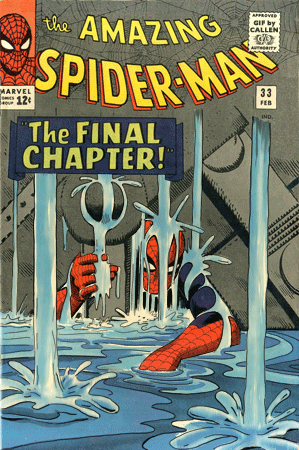
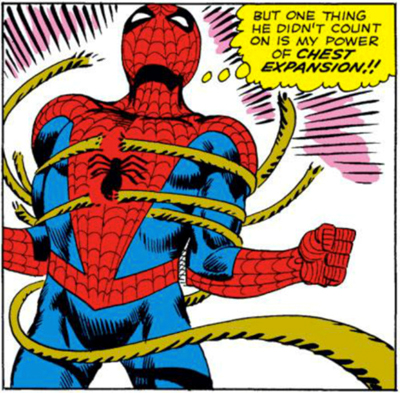
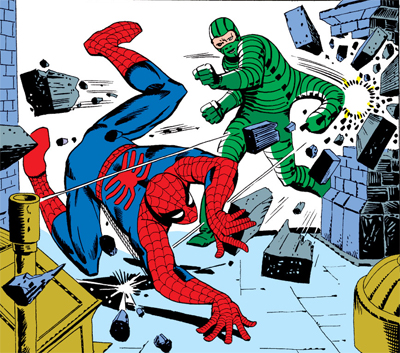


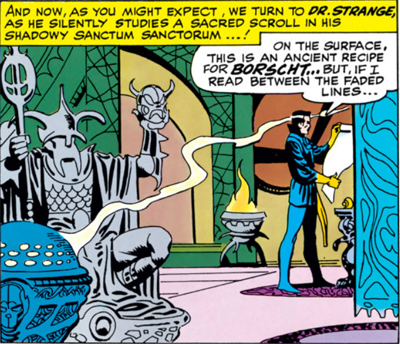


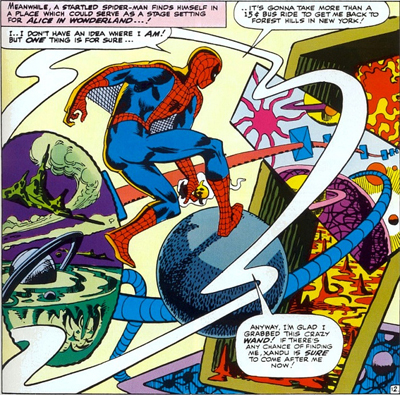


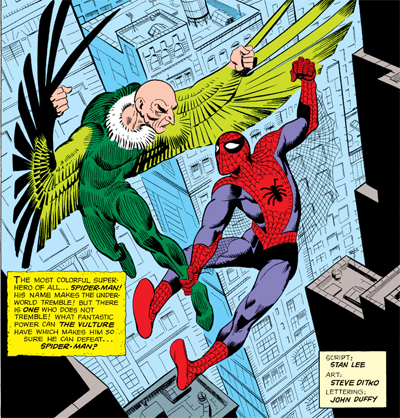



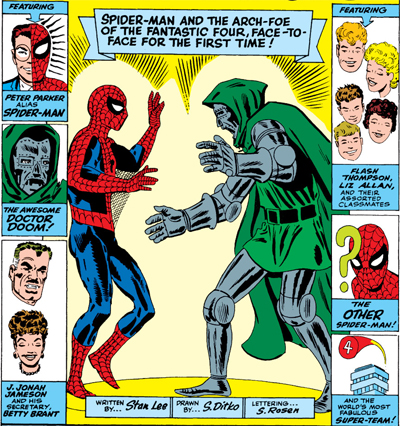

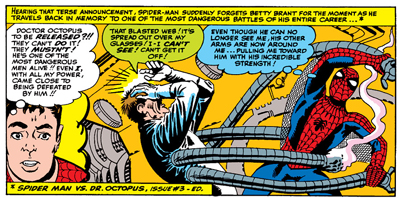
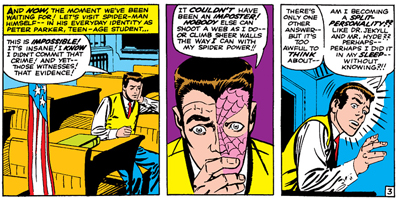



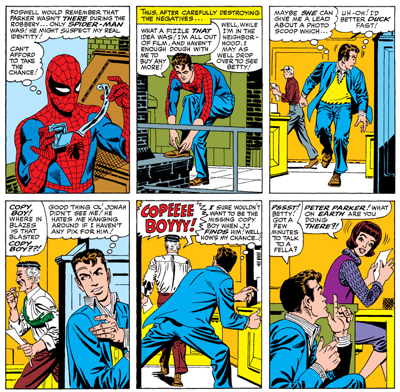




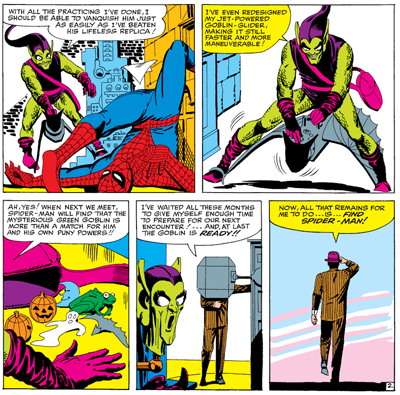
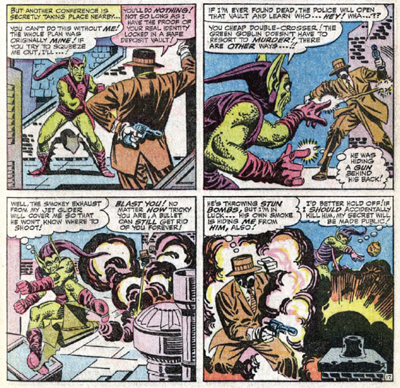





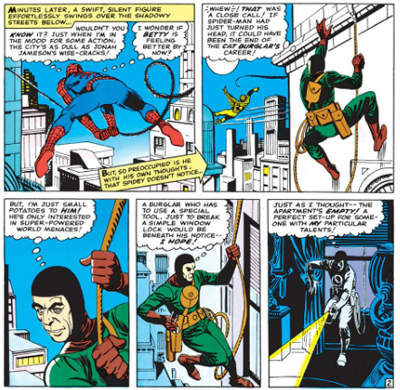

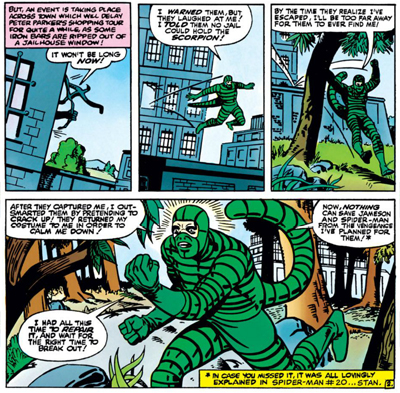

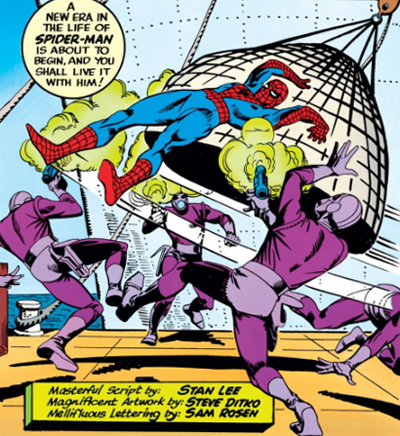






“subjectivism, a philosophical ideology aligned against subjectivism.”???
Apologies, Martin. That has been corrected. It should, of course, read “objectivism.”
I could talk about Ditko for hours with you. Have you read Blake Bell’s book about him?
I think of this run, Mysterio is really the third greatest villain behind Doctor Octopus and the Green Goblin. His initial appearance carefully painted him as an evil version of Spider-Man and the his following solo appearance posing as Spider-Man’s psychiatrist was even better.
Yep. Mysterio is probably the classic Spider-Man villain who is hardest to get a read on. (Well, outside maybe Crime-Master.) I think he’s waiting for his “Kraven’s Last Hunt” storyline. I think Guardian Devil is probably the biggest Mysterio story out there, and that is quite transparent about how disappointing it is that it isn’t a Spider-Man story. (Although he’s pretty crucial to Spider-Men, he’s really just a storytelling tool there.)
I owe an apology to Mysterio because for the longest time I had no care for him because “he wasn’t Venom or Carnage”. Mysterio is now my favorite B-list Spider-Man villain (Venom will always be A-list, but for more profound reasons now).
Mysterio is pretty great. It’s amazing he hasn’t featured in any of the film adaptations.
I’d still say Ultimate Spider-Man is the best run for the character and the overall best Spider-Man story as a whole.
Yep. I think there is a barrier that exists with the Silver Age material that holds it back, but these stories really do hold up very well. But they aren’t as accessible as Ultimate Spidey, which helped to get me into comics.
One thing I’d like to note is you were right about Amazing Fantasy #15. I do rather love that issue as a beginning to Spider-Man, but it’s far from the best issue here.
The reason the Goblins plan involves a movie set was Stan originally evisioned a movie credit shooting out west and digging up a sarcophagus containing the undead Green Goblin. Steve Ditko reworked the plot to include him as a human villain.
I did not know that! Cheers!
On a note of the Ditko – Lee debate, I should bring up Ditko is supposed to be Peter Parker and Lee as Jameson. That should give you an idea on why Ditko left.
Ha. That’s a nice analogy. Although Jameson’s no Funky Flashman!